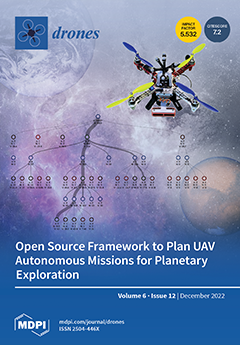Field surveys in wetlands are limited by the difficulty in accessing the site, hazards during surveys, and the risk of disturbing the ecosystem. Thus, the use of unoccupied aerial vehicles (UAVs) can overcome these limiting factors and can assist in monitoring small organisms,
[...] Read more.
Field surveys in wetlands are limited by the difficulty in accessing the site, hazards during surveys, and the risk of disturbing the ecosystem. Thus, the use of unoccupied aerial vehicles (UAVs) can overcome these limiting factors and can assist in monitoring small organisms, such as plants and insects, that are unique to wetlands, aiding in wetland management and conservation. This study aimed to demonstrate the effectiveness of a survey method that uses a small drone equipped with a telephoto lens to monitor dragonflies, which are unique to wetlands and have been difficult to survey quantitatively, especially in large wetlands. In this study, the main target species of dragonflies was
Nannophya pygmaea, which is the world’s smallest dragonfly (about 20 mm long). The study area was Mizorogaike wetland (Kita Ward, Kyoto City, Japan). The UAV was flown at a low speed at an altitude of 4 m to 5 m, and images were taken using 7× telephoto lens on Mavic 3 (7× optical and 4× digital). A total of 107 dragonflies of seven species were identified from the photographs taken by the drone.
N. pygmaea, about 20 mm long, was clearly identified. Eighty-five dragonflies belonging to
N. pygmaea were identified from the images. Thus, by using a small drone equipped with a telephoto lens, the images of
N. pygmaea were captured, and the effects of downwash and noise were reduced. The proposed research method can be applied to large wetlands that are difficult to survey in the field, and can thus provide new and important information pertaining to wetland management and conservation. This research method is highly useful for monitoring wetlands as it is non-invasive, does not require the surveyor to enter the wetland, requires little research effort, and can be repeated.
Full article





